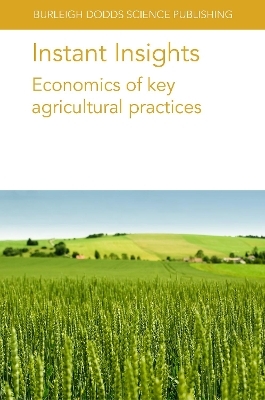
Instant Insights: Economics of Key Agricultural Practices
Burleigh Dodds Science Publishing Limited (Verlag)
978-1-80146-602-8 (ISBN)
This collection features six peer-reviewed reviews on the economics of key agricultural practices.
The first chapter assesses the economic impact of horticultural crops and integrated pest management programmes. The chapter highlights the importance of considering agricultural system design and the utilisation of novel control tactics.
The second chapter considers the economic consequences of novel integrated weed management (IWM) strategies, as well as the different approaches used to assess the economics of IWM strategies.
The third chapter reviews developments in methods to assess the economic value of agricultural biodiversity. The chapter also outlines the limitations of these methods and proposes a possible, novel way forward.
The fourth chapter provides an overview of the economic barriers faced by smallholder farmers, including land, labour, capital and inputs, and their impact on farm profitability.
The fifth chapter reviews the economics of soil health, focussing on the adoption of soil health management practices by farmers and the effectiveness of incentives.
The final chapter examines the use of economic research as a tool to determine the profitability and adoption potential for a number of precision agriculture technologies.
Chapter 1 - Assessing the economics of integrated pest management for horticultural crops: Philip R. Crain and David W. Onstad, Corteva Agriscience, USA; 1 Introduction2 Concepts of economic thinking3 Economic impact of horticultural crops and case studies on the complexity of integrated pest management4 Conclusion5 Future trends in research6 Where to look for further information7 References
Chapter 2 - Evaluating the economics of integrated weed management: Pieter de Wolf, Saskia Houben, William Bijker and Koen Klompe, Wageningen Plant Research, The Netherlands; 1 Introduction2 Approaches to economic evaluation3 The case study in IWMPRAISE4 Comparing the economics of different integrated weed management strategies5 Different approaches in assessing the economics of integrated weed management strategies6 Comparing different approaches in the economic evaluation of integrated weed management strategies7 Where to look for further information8 References
Chapter 3 - Assessing the economic value of agricultural biodiversity: a critical perspective: Corrado Topi, Stockholm Environment Institute at York, Department of Environment and Geography and Interdisciplinary Global Development Centre, University of York, UK; and Leonie J. Pearson, Stockholm Environment Institute, Thailand; 1 Introduction2 The relationship between definitions and economic approaches3 What does valuing agricultural biodiversity mean?4 The ecosystem services framework (ESF)5 Ecosystem interactions6 Understanding the limitations of ecosystem service valuations7 The investor perspective: the natural environment as a legally structured persona8 Conclusions9 References
Chapter 4 - The economics of smallholder farming: David Eagle and Nadira Saleh, Mennonite Economic Development Associates (MEDA), Canada; 1 Introduction2 Segmentation3 Land4 Labour5 Capital6 Inputs7 Market access8 Decision-making9 Case study: BEST Cassava10 Summary11 Where to look for further information12 References
Chapter 5 - The economics of soil health: Maria Bowman, ERS-USDA, USA; 1 Introduction2 Use of key soil health practices by farmers in the USA3 Costs and benefits of soil health practices4 Case studies in soil health: strengths and limitations5 Public benefits of soil health and soil health management practices6 Barriers to adoption of soil health practices7 Evaluating the role of federal and state regulations, policies and incentive programmes8 Future trends and conclusion9 Where to look for further information10 References
Chapter 6 - The economics of precision agriculture: James Lowenberg-DeBoer, Harper Adams University, UK; 1 Introduction2 Adoption of PA technology3 PA adoption and economics4 Predicting future trends based on recent studies of PA profitability5 Future trends and conclusion6 Where to look for further information7 References
| Erscheinungsdatum | 18.01.2023 |
|---|---|
| Reihe/Serie | Burleigh Dodds Science: Instant Insights ; 70 |
| Zusatzinfo | Color tables, photos and figures |
| Verlagsort | Cambridge |
| Sprache | englisch |
| Maße | 152 x 229 mm |
| Gewicht | 230 g |
| Themenwelt | Naturwissenschaften ► Geowissenschaften ► Geografie / Kartografie |
| Weitere Fachgebiete ► Land- / Forstwirtschaft / Fischerei | |
| ISBN-10 | 1-80146-602-5 / 1801466025 |
| ISBN-13 | 978-1-80146-602-8 / 9781801466028 |
| Zustand | Neuware |
| Informationen gemäß Produktsicherheitsverordnung (GPSR) | |
| Haben Sie eine Frage zum Produkt? |
aus dem Bereich


